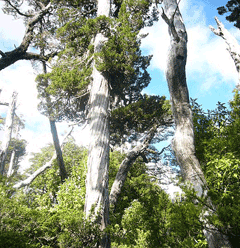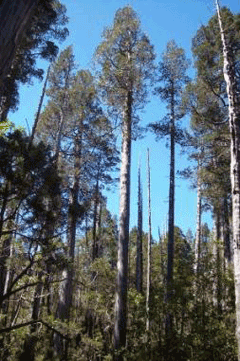 |
|
|
 |
| http://commons.wikimedia.org/wiki/User:Lin_linao |
Translate this page:
Summary
Physical Characteristics

 Fitzroya cupressoides is an evergreen Tree growing to 10 m (32ft) by 6 m (19ft) at a slow rate.
Fitzroya cupressoides is an evergreen Tree growing to 10 m (32ft) by 6 m (19ft) at a slow rate.
See above for USDA hardiness. It is hardy to UK zone 8. It is in leaf all year, and the seeds ripen in October. The species is dioecious (individual flowers are either male or female, but only one sex is to be found on any one plant so both male and female plants must be grown if seed is required). and is pollinated by Wind.
Suitable for: light (sandy), medium (loamy) and heavy (clay) soils. Suitable pH: mildly acid and neutral soils and can grow in very acid soils.
It can grow in semi-shade (light woodland) or no shade. It prefers moist soil.
UK Hardiness Map
US Hardiness Map
Synonyms
F. patagonica. Pinus cupressoides.
Plant Habitats
Woodland Garden Canopy; Secondary;
Edible Uses
References More on Edible Uses
Medicinal Uses
Plants For A Future can not take any responsibility for any adverse effects from the use of plants. Always seek advice from a professional before using a plant medicinally.
None known
References More on Medicinal Uses
The Bookshop: Edible Plant Books
Our Latest books on Perennial Plants For Food Forests and Permaculture Gardens in paperback or digital formats.

Edible Tropical Plants
Food Forest Plants for Hotter Conditions: 250+ Plants For Tropical Food Forests & Permaculture Gardens.
More

Edible Temperate Plants
Plants for Your Food Forest: 500 Plants for Temperate Food Forests & Permaculture Gardens.
More

More Books
PFAF have eight books available in paperback and digital formats. Browse the shop for more information.
Shop Now
Other Uses
Fibre Wood
A fibre obtained from the inner bark is used for caulking boats[139]. Wood - light, very durable, immune to insect attacks, of excellent quality. It is used for construction, carpentry, musical instruments etc[46, 61, 139].
Special Uses
References More on Other Uses
Cultivation details
This species dislikes soils that dry out rapidly, preferring an acid soil with a pH around 5[200]. It grows best in humid conditions, especially on north facing slopes or in the shelter of a woodland edge[200]. It dislikes cold drying winds[200]. A very ornamental tree[1], it is much hardier in Britain than was once thought[11]. Generally a very slow growing tree in Britain but young plants can grow 30cm a year and growth can continue until October[185]. A very slow growing and long-lived tree in its native habitat[139, 200], probably to 3000 years or more, but trees are unlikely to survive that long in Britain[200]. Plants grow best in the mild and damp maritime climate of south-west and west Britain[185, 200]. Plants can be monoecious or dioecious, though they are more often dioecious. Male and female plants must be grown if seed is to be produced, though there is a report that trees rarely produce fertile seed in Britain[200]..
References Carbon Farming Information and Carbon Sequestration Information
Temperature Converter
Type a value in the Celsius field to convert the value to Fahrenheit:
Fahrenheit:
The PFAF Bookshop
Plants For A Future have a number of books available in paperback and digital form. Book titles include Edible Plants, Edible Perennials, Edible Trees,Edible Shrubs, Woodland Gardening, and Temperate Food Forest Plants. Our new book is Food Forest Plants For Hotter Conditions (Tropical and Sub-Tropical).
Shop Now
Plant Propagation
Seed - we have no information on this species but suggest sowing the seed in early spring in a cold frame. When they are large enough to handle, prick the seedlings out into individual pots and grow them on in the greenhouse for at least their first winter. Once they have reached a height of at least 30cm, plant them out into their permanent positions in late spring or early summer, after the last expected frosts[200]. Cuttings, August, in a sandy soil in a frame[1].
Other Names
If available other names are mentioned here
Native Range
SOUTHERN AMERICA: Argentina (Chubut, Neuquén, Río Negro), Chile (Los Lagos)
Weed Potential
Right plant wrong place. We are currently updating this section.
Please note that a plant may be invasive in one area but may not in your area so it's worth checking.
Conservation Status
IUCN Red List of Threatened Plants Status :

Growth: S = slow M = medium F = fast. Soil: L = light (sandy) M = medium H = heavy (clay). pH: A = acid N = neutral B = basic (alkaline). Shade: F = full shade S = semi-shade N = no shade. Moisture: D = dry M = Moist We = wet Wa = water.
Now available:
Food Forest Plants for Mediterranean Conditions
350+ Perennial Plants For Mediterranean and Drier Food Forests and Permaculture Gardens.
[Paperback and eBook]
This is the third in Plants For A Future's series of plant guides for food forests tailored to
specific climate zones. Following volumes on temperate and tropical ecosystems, this book focuses
on species suited to Mediterranean conditions—regions with hot, dry summers and cool, wet winters,
often facing the added challenge of climate change.
Read More
Expert comment
Author
(Molina.)I.M.Johnst.
Botanical References
11139200
Links / References
For a list of references used on this page please go here
Readers comment